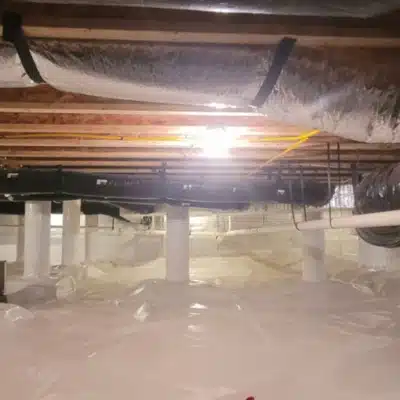Rotted Wood
Rotted wood is one of the most destructive signs of a problem within your crawl space. It can cause floor collapse and contribute to mold and mildew growth.

Rotted Wood Repair in Northern Virginia, Shenandoah Valley, North Central Virginia, and West Virginia
Virginia receives a higher amount of rainfall than usual each year. Moreover, the summer months bring along sticky and humid days. These two factors together lead to rotted wood in an uncovered crawl space. As time passes, moisture seeps into the wooden beams that support your home’s floors and walls, causing them to deteriorate and become weak, compromising the structural integrity of your home.
Fortunately, LUX Foundation Solutions has the necessary tools and expertise to safeguard your crawl space and home. Schedule a free estimate today and let the experts assess the situation. We proudly serve homeowners in Northern Virginia, Shenandoah Valley, North Central Virginia, West Virginia, and surrounding areas.
Do These Rotted Wood Signs Seem Familiar?
The symptoms
Rotted wood is a fungus that feeds on wood that causes it to decompose over time. It can manifest in various ways. If your crawl space has wood components, it’s important to identify the signs early on that can indicate larger foundation issues.
Here are some common signs of rotted wood to keep in mind:
- Soft or spongy wood
- Discoloration or darkening of the wood
- Foul, musty odors
- Visible fungi or mold growth
- Insect infestation, such as termites or carpenter ants
- Crumbling or flaking wood
These symptoms can indicate a more significant moisture problem in your crawl space. If you notice any of these signs, it’s important to have your crawl space inspected by a professional as soon as possible. At LUX Foundation Solutions, we offer free estimates and can help you decide on the best course of action to address your rotted wood problems.

Soft wood

Discolorations

Musty odor
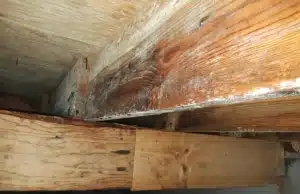
Mold growth

Termite infestations
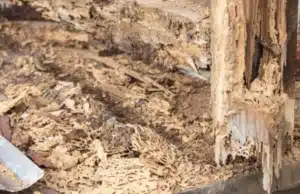
Decaying wood
What Causes Rotted Wood?
Rotted wood occurs due to the presence of excess moisture in the crawl space, which creates a favorable environment for fungi to grow and decay wood. Understanding the common causes can help you prevent future issues:

Poor Ventilation
Inadequate ventilation in the crawl space can lead to the accumulation of moisture-laden air. When warm, humid air enters the crawl space and encounters cooler surfaces, such as wooden beams and joists, condensation forms. Over time, this persistent moisture can cause the wood to become damp and eventually rot. Proper crawl space ventilation is crucial to maintaining a dry environment and preventing wood rot.
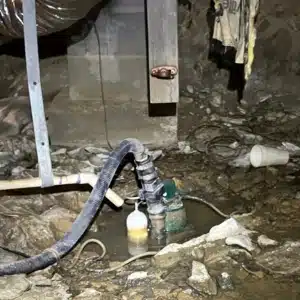
Plumbing Issues
The crawl space in your home holds important systems, including plumbing lines. These lines, although essential for various functions, can cause damage to the wood in your crawl space. If any appliances leak or become clogged, the pipes in the crawl space might burst, resulting in significant water flooding the foundation and saturating the wooden support beams. When wood absorbs water, especially in a damp environment like a crawl space, it often leads to rotted wood.
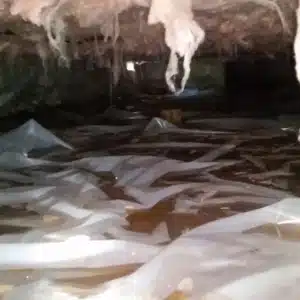
Excess Moisture or Humidity
Excessive moisture or humidity poses a significant problem for exposed wood, increasing the risk of rotted wood in such conditions. Since crawl space beams are situated beneath your home, they remain constantly exposed to the prevailing weather conditions outside.
On hot summer days, a substantial amount of moisture can penetrate your crawl space and be absorbed by the wood. What’s worse, when humidity lingers beneath your crawl space, it faces difficulties in escaping. As a result, the wooden structures beneath your home effectively soak in the humid air. Over time, the wood beams progressively weaken as they absorb more and more water vapor.
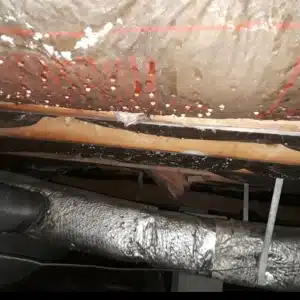
Condensation
Condensation results from humid air, which accelerates the formation of rotted wood. This happens when the air can no longer hold the water vapor it contains. It’s crucial to understand that cold air has a lower capacity to hold water vapor than warm air. Since the air in your crawl space is naturally cooler than the air outside, increasing humidity leads to a rapid conversion of water vapor into condensation.

Poor Drainage
Poor drainage around the foundation of the home can contribute to water pooling in the crawl space. When water from rain, groundwater, or plumbing leaks is not directed away from the crawl space effectively, it can saturate the soil and the wooden structural components. This prolonged exposure to moisture creates the ideal conditions for wood rot to develop.

Open Vents
Open vents in crawl spaces are considered a design flaw. It was previously believed that crawl spaces with vents would allow humid air to escape to the outside. However, the opposite is actually true – open vents allow humid air to enter the space. When wood is exposed to excessive moisture, it can lead to structural deterioration.
To prevent rotted wood, it’s essential to address these underlying causes. Schedule a free estimate with LUX Foundation Solutions to identify the root cause of the issues and explore effective solutions.
Our Solutions
If you’re experiencing rotted wood in your crawl space due to moisture, improving ventilation alone may not be enough to prevent future problems. While those measures might help in some cases, they don’t always address the root cause of the problem. That’s because crawl spaces are naturally damp environments, and moisture can come in through various sources, including groundwater infiltration, condensation, cracks in the foundation, and humidity. The team at LUX Foundation Solutions offers the best solution for preventing rot and moisture damage in your crawl space: invest in professional-grade dehumidification, crawl space encapsulation, proper crawl space vents, and door closures.
Crawl space encapsulation involves sealing off the crawl space with a vapor barrier to prevent moisture from entering in the first place. It creates a moisture barrier that prevents external humidity and moisture from entering the space. Furthermore, it helps maintain a stable temperature, which prevents rot by eliminating the conditions that promote it.
In addition, installing a dehumidifier is essential in regulating the moisture levels within the crawl space by removing excess humidity from the air. This helps prevent mold and mildew growth, which are common culprits in causing wood rot.
Also, proper crawl space vents and door closures are equally important. While ventilation can be beneficial, it needs to be controlled. They should be appropriately sealed and managed to prevent excess moisture intrusion, especially during wet seasons. This step is critical for maintaining a controlled environment in your crawl space.
The LUX Foundation Solutions team specializes in crawl space moisture solutions and can work with you to design a custom solution that meets your needs and budget. By addressing the issue with a professional solution, you can protect your home from future damage and maintain its structural integrity for years to come.
If you notice minor termite damage in your floor joists, it’s crucial to address the issue immediately. Termites can quickly cause wood rot, leading to weakened structural integrity and potentially dangerous living conditions. It’s best to seek professional assistance to ensure proper repair and prevent future damage.
One solution offered by LUX Foundation Solutions is floor joist sistering. This involves adding a new, solid piece of wood next to the minor damaged joist to provide extra support and stability. The two pieces of wood are then bolted together to create a secure bond. Professionals can do This process quickly and efficiently, allowing you to promptly get back to your everyday routines without worrying about floor damage. By reinforcing the damaged area, this solution can also help prevent future termite damage and wood rot.
Repairing a rotted wood main beam is a critical structural issue, and LUX Foundation Solutions offers a reliable solution known as “main beam replacement.” When the main beam of a structure deteriorates due to rot, it can compromise the building’s stability and safety.
Main beam replacement involves the removal of the rotted beam and replacing it with a new, sturdy one. This process is vital because it restores the load-bearing capacity and stability of the structure. The new beam is typically made of treated wood or other materials resistant to rot and decay, ensuring long-lasting support.
Engaging professionals is vital as it guarantees a safe and durable solution. Main beam replacement is a comprehensive approach that not only eliminates the rotted wood but also ensures your house’s structural soundness, providing a reliable and lasting fix for the rotted wood main beam.
LUX Foundation’s experts are well-equipped to precisely perform main beam replacement, effectively addressing the core problem. Our professional approach ensures the new beam is correctly installed, securing the structure and preventing further deterioration of your home.
Prevent Rotted Wood Damage — Call LUX Foundation Solutions for A Free Estimate Today!
Rotted wood can lead to numerous issues for your home and its foundation. We understand how to prevent crawl space problems from taking over your home. Many homeowners in Northern Virginia, Shenandoah Valley, North Central Virginia, West Virginia, and nearby areas have relied on us for their crawl space repair needs.
With high-quality equipment and a team with over 50+ years of combined experience, you can trust that your crawl space will receive state-of-the-art service.
Don’t let rotted wood compromise the stability of your home’s foundation. Contact LUX Foundation Solutions for a free estimate or fill out our online estimate request form to schedule a free, on-site estimate, and let us provide you with the right solution for your crawl space issues.
Request a free Estimate
FAQ's
Rotted wood can cause significant damage to your crawl space. As moisture seeps into the wood, it creates the ideal conditions for fungi to grow and thrive. Over time, the fungi break down the cellulose in the wood, weakening its structural integrity. This can lead to sagging floors, deteriorating support beams, and even the potential for structural collapse if left untreated.
Regular inspection, proper ventilation, and moisture control are essential to prevent the issue and preserve the integrity of your crawl space. It’s important to address any rotting wood as soon as possible by contacting a crawl space repair service that can identify the cause and resolve the issue before it gets worse.
To keep your home’s crawl space safe against rotted wood, there are several key steps you can take:
- Ensure proper ventilation in the crawl space to allow for adequate air circulation and prevent excessive moisture buildup.
- Address any water leaks or plumbing issues promptly to prevent water infiltration. Maintaining a dry environment using dehumidifiers or moisture barriers is also essential.
- Conduct regular inspections for signs, such as soft or discolored wood, and promptly address any issues.
- If you suspect that your home has already been affected, it’s crucial to contact an expert foundation repair service to assess and repair the underlying issues.
By taking these preventative measures, you can ensure the safety and longevity of your home’s crawl space.
Yes, rotted wood is a serious issue that can threaten your family’s health and safety. It can contribute to the growth of mold and mildew, which can pose health risks. Mold spores released by the fungi that thrive in rotting wood can cause respiratory problems, allergic reactions, and other health issues, especially for individuals with pre-existing conditions or weakened immune systems. The decaying wood can attract pests like termites, ants, and other insects that can carry disease and bacteria into your home.
Moreover, wood weakened by rot can compromise the structural integrity of your home, leading to sagging floors and collapsing support beams, making it more vulnerable to collapse or other safety hazards. It’s crucial to address it promptly and mitigate moisture issues to prevent mold growth and ensure a healthy living environment for your family. Regular inspections and proper ventilation are vital in maintaining a safe and healthy home.
While plenty of DIY tutorials are available online, fixing rotted wood is not a task that homeowners should undertake by themselves. Not only can it be hazardous to your health, but it can also lead to further damage if not done properly.
Hiring an expert crawl space repair service will help determine the root cause of the problem and remedy it effectively. This can potentially save costly repairs in the future and ensure that your home remains safe and stable.



